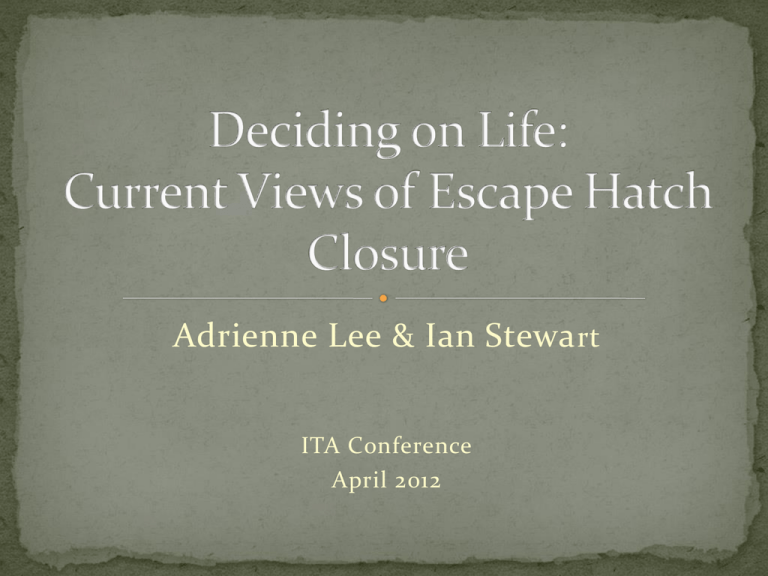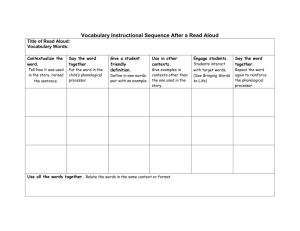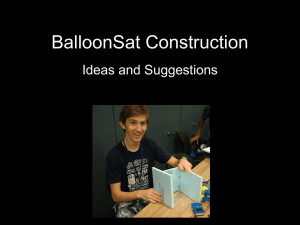CLOSING ESCAPE HATCHES
advertisement

Adrienne Lee & Ian Stewa rt ITA Conference April 2012 Each individual has four destiny choices… 1. Getting Better (Staying Well) 2. Getting Rid of People (Homicide) 3. Psychosis or Criminality 4. Despairing Self-Destruction (Suicide) “Only by a clear understanding between the patient’s Child and his Adult can the march towards doom sometimes be reversed by the Adult taking control” Life Path CLOSE the Escape Hatch “No matter what happens, I will not kill myself accidentally or on purpose at any time” Bob Goulding (1973) “I will not hurt or kill anyone else in any way, accidentally or on purpose, and I will not set up for anyone else to do it for me.” “I will live a healthy , full life and promote the same in others.” Ken Mellor (1979) (1) … means DECIDING not to kill or harm self or others, or go crazy. (2) These are DECISIONS (and not contracts). (3) These decisions are taken from Adult, over-riding Child and Parent if necessary (4) These decisions are UNCONDITIONAL. (5) They are taken FOR ALWAYS. (6) They are decisions for SELF (not “promises” to the therapist). Myth No. 1: ‘Once the hatches have been closed, the client is forbidden ever to speak about them again.’ Myth No. 2: ‘Escape-hatch closure is done for the comfort of the therapist, rather than the benefit of the client.’ Myth No. 3: ‘It is possible to close escape hatches from Child as well as from Adult.’ Myth No. 4: ‘In closing escape hatches, the client must adapt to the therapist.’ Myth No. 5: ‘The hatches must be closed in the first session’ (or ‘first few sessions’). Myth No. 6: ‘Hatch closure should be set as a rule.’ Myth No. 7: ‘Escape-hatch closure is done by rote’ (or ‘is merely a ritual’). Closing escape hatches, and keeping them closed, is the client’s responsibility, not yours. (Your tasks are to offer the procedure to the client, then monitor and reflect back any incongruity.) Stay OK-OK. You and your client are both OK whether or not she closes the hatches. Don’t press. Whether, and when, to close the hatches is a matter for the client to choose. Stay in Adult yourself throughout the procedure. Keep monitoring yourself for ego-state shifts and incongruities. You need to have closed your own hatches before you can reliably facilitate others to do so. In the last analysis, you can never be sure that the client has his hatches closed. The most you can do is to make a professional judgment on the matter, in the form of an acceptable probability. Be aware of, and abide by, the “3 Don’ts of Escape-Hatch Closure”: Don’t try to set Hatch closure as a “rule”. Don’t try to get closure “by rote”. Don’t invite closure too early. a. Explain what is meant by “closing escape hatches” and offer wording the client can use if she wants to close them. (For example: “I will not, in any circumstances, kill or harm myself, try to kill or harm myself, or set up to kill or harm myself, accidentally or on purpose”). b. For each of the three hatches separately, ask if the client is willing to close that hatch. If willing, proceed to steps (c) through (f). If not willing, go to step (g) and complete steps (g) through (k). c. Invite the client to make the statement for each hatch separately. For each one in turn: d. Look and listen for any incongruity, verbal or non-verbal. Use Little Professor as well as Adult. If in any significant doubt, assume the hatch has not been closed. e. If closure is congruent, test with: “Is that statement true for you?” f. If still congruent, reflect back that the client has closed the hatch. Stroke the client (from Adult). (The following steps will only apply if the client has not congruently closed the hatch): g. If unwilling/incongruent: register hatch not closed. Underline that this is the client’s current choice, and ensure OK-OK position is clear. h. You may then move into inviting the client to explore her scripty scare or other source of unwillingness to let go of hatches. In any event, before the end of the session you MUST proceed with the following steps. Make sure you leave adequate time to do so: i. Invite time-limited closure of whatever hatch(es) the client did not close. For example, you might ask: “For how long are you willing to keep the suicide hatch closed?” As the client replies, again look and listen for any incongruities and reflect them back. In this process, always address all three hatches at the same session. (I.e. do not, for example, facilitate the client to close the homicide and go-crazy hatches while leaving suicide open; instead, you would invite time-limited closure on suicide before the end of the session). j. Record the agreed time-limit(s) in your case notes. Re-check time-limited closures before the time-limit is up, and invite renewed timelimited closure or full closure. k. If client is unwilling to close a hatch for even the shortest time, initiate emergency procedure appropriate to whatever hatch is open. “It is of course possible that patients may interpret such a decision procedure to mean that they cannot explore their suicidal, homicidal or psychotic aspects and fantasies. This can rob them of an existential choice to take responsibility for their own lives (its irritations, grief and beauty) of depth and poignancy. Social control may be achieved, but experienced as a prohibition from the psychotherapist to plumb such depths of the human psyche even in long term psychotherapy” Petruska Clarkson (1992) AUTONOMY SYMBIOSIS Over Adaptation Contract Choice P P P P P A A A A A C C C C C “I promise….” “I will not……” “I choose not…” SUICIDE HOMICIDE GOING CRAZY JOYLESS Overwork Overeating Smoking Anorexia/O besity Dangerous driving Self Harming Suicide attempts SUICIDE LOVELESS Withdrawal Arguments Conflict Verbal Abuse Road-Rage Racism Violence HOMICIDE MINDLESS Running Away 1st Degree Lying Wild Parties Dropping Out Alcoholism 2nd Degree Substance Abuse Drug Addiction GOING CRAZY 3rd Degree SELF ACTUALISATION HEALTHY LIVING RESPONSIVE RELATIONSHIP COMPASSION AWARENESS RESPONSIBILITY SUICIDE HOMICIDE GOING CRAZY AUTONOMY - JOYFUL SELF ACTUALISA -TION Healthy Living Meditation Healthy Eating & Drinking Learning Therapy Exercise and Fun Positive Thinking INTIMACY – LOVE FULL FULL RELATIONSHIP Compassion Caring Relationships Service to Community Charity Gratitude Engagement with others Community Awareness Continuing Education Home Building Work AWARENESS - MINDFUL RESPONSIBILITY Active and Committed Life Eco Awareness and Practice SELF ACTUALISATION HEALTHY LIVING JOYFUL I+ SUICIDE JOYLESS RESPONSIVE RELATIONSHIP COMPASSION U+ LOVE FULL HOMICIDE LOVELESS AWARENESS RESPONSIBILITY I+U+ MINDFUL I- UGOING CRAZY MINDLESS I-U- “If you are capable of living deeply one moment of your life you can learn to live the same way all the other moments of your life.” Thich Nhat Hanh Enjoy Life Love and Responsibility










